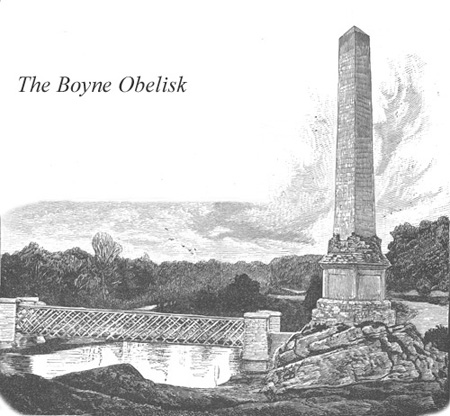Oldbridge - Irish Pictures (1888)
From Irish Pictures Drawn with Pen and Pencil (1888) by Richard Lovett
Chapter III: The Valley of the Boyne … continued
« Previous Page | Start of Chapter | Book Contents | Next Page »
Leaving the town in a jaunting car, and travelling by a road skirting the southern bank of the Boyne, whence fine views are obtained, Oldbridge is reached after a short drive. This name is now somewhat of a misnomer, as a comparatively new bridge spans the stream. But the interest of the scene, apart from its rural beauty, which is very great, centres in the event commemorated by the obelisk standing hard by the northern end of the bridge. Upon a huge irregular block of granite rises a massive column, erected in 1736, bearing this inscription: 'Sacred to the glorious memory of King William the Third, who, on the 1st of July, 1690, passed the river near this place to attack James the Second at the head of a Popish army, advantageously posted on the south side of it, and did, on that day, by a single battle, secure to us and to our posterity, our liberty, laws, and religion. In consequence of this action, James the Second left this kingdom and fled to France.'
On this eventful day William's army was posted along the north bank, and James's clustered around Donore Hill, on the south side of the river. Part of the English army crossed early in the morning by a ford a few miles up the river, thus outflanking the left wing of the Irish army and throwing it into some confusion. At this moment the remainder of William's army crossed at Oldbridge, a severe struggle taking place, in which the Duke of Schomberg, Walker of Derry, and others were slain, James, it must be admitted, did nothing to encourage his army, and very early in the day fled to Dublin. Many of his troops fought bravely, but they were out-generalled, and were unable to stand before the trained valour of William's troops. The Irish army was routed and pursued some six miles beyond Duleek.
The site of this battle is interesting on many accounts, and the results of the victory were of the highest importance. But the associations of angry political passion, bloodshed and strife, seem strangely unsuitable to the peaceful scenes and lovely landscapes of the district; and so we gladly pursue our journey to places which speak to us of better things than war and bloodshed. From the northern end of the bridge a little dell runs up through the hill. It is well wooded and a carriage road passes through it. It is known now as King William's Glen, because part of his army was posted here, and because he reached the river bank by this road on the day of his eventful crossing. The road leads up to the higher ground, and after a drive of from two to three miles, the ruins of Mellifont Abbey come into view. The drive is enjoyable, but not nearly so fine as many others in this neighbourhood. The car turns into a narrow valley, and after running a short distance, suddenly and without any indication of the nearness of the ruins, brings the traveller to the peaceful shut-in cul-de-sac occupied by Mellifont.
« Previous Page | Start of Chapter | Book Contents | Next Page »

